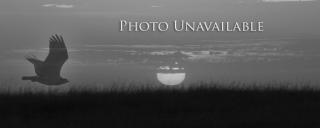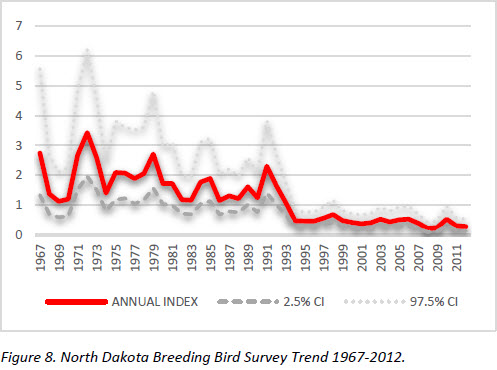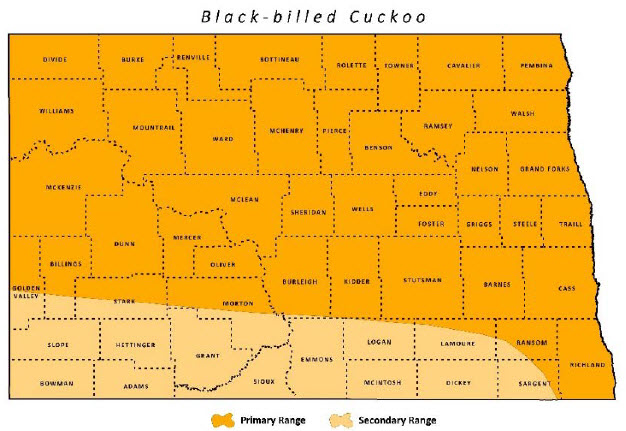
Black-billed Cuckoo
| Scientific Name | Coccyzus erythropthalmus |
|---|---|
| General Description | L 12”, WS 17.5”, 1.8 oz. Slender, long-tailed, brown upperside, and off-white underneath. The black bill and red eye ring distinguish it from the yellow-billed cuckoo. |
| Status | Occurs in North Dakota from mid-May to mid-September. Peak breeding season mid-June to late July. |
| Abundance | Fairly common to rare. |
| Primary Habitat | Brushy margins or woodland openings, thickets of small trees and prairie shrubs. |
| Federal Status | Migratory Bird. |
| Reason for Designation | Black-billed cuckoos are declining across North America It is included on the USFWS Bird of Conservation Concern list in Region 6, BCR 11, and 17. Partners in Flight (PIF) identifies the Black-billed Cuckoo as a Regional Concern Species, U.S.-Canada Species of Concern, and a Common Bird in Steep Decline. |
Locations and Conditions of Key Habitat
Preferred Habitat
In North Dakota, cuckoos are most likely present in brushy margins or openings of woodlands, and thickets of small trees or shrubs on the prairie. Also uses riparian areas, shelterbelts, and wooded areas of towns and farmsteads. Nest in trees or thick brush usually 1-2 meters above the ground. Primarily insectivorous, feeding on large caterpillars, beetles, grasshoppers, crickets, butterflies, and occasionally fruits. Cuckoos will even readily consume noxious species such as tent caterpillars. May be area sensitive, requiring larger tracts (at least 1 ha) of forest habitat.
Key Areas and Conditions for Black-billed Cuckoos in North Dakota
Pembina Hills, Turtle Mountains, wooded hills in the Devils Lake area, wooded stream valleys in the Red River Valley, Sheyenne, James, Mouse, Souris, Knife, Cannonball and Missouri Rivers are probably the most frequented areas.
Problems Which May Affect this Species
Habitat
Destruction and/or degradation of native riparian habitat. Development in wooded areas along major rivers may be limiting cuckoo nesting habitat. Overgrazing of woody draws and other woodlands affects the vegetative structure and composition.
Other Natural or Manmade Factors
Black-billed Cuckoos rely heavily on caterpillars for food and can be especially gregarious during caterpillar outbreaks. Insecticides will reduce prey availability. Some mortality from collisions with structures and communication towers, probably in part due to nocturnal migration behavior.
Research and Survey Efforts
Current Research or Surveys
- Nothing specific to the species in North Dakota.
Previous Research or Surveys
- Little effort has been directed to specific research or surveys for Black-billed Cuckoos in North Dakota.
- A few surveys focused on all woodland or woody draw associated birds in western North Dakota in the early to mid- 1980’s.
- Fair number of published reports and gray literature throughout the species range.
Additional Research or Surveys Needed
- A survey of the cuckoo along with other riparian or upland deciduous forest nesting species, similar in scope and location to the surveys of the early 1980’s, to determine the status of the population and factors affecting the decline of the species.
- Demographic or life history information is lacking, such as spacing, site tenacity, fecundity and mortality, and population structure and regulation.
- Determine the effects of contaminants or pesticide use on prey.
Population and Trend Estimates

- PIF Global Population Estimate: 870,000
- PIF North American Population Estimate: 870,000
- PIF North Dakota Population Estimate: 30,000
- North Dakota BBS Trend: see figure 8
- Survey-wide BBS Trend 1966-2012: -2.00
Management Recommendations
- Identify native riparian habitats at risk.
- Limit or exclude grazing in riparian areas.
- Choose insecticides with the lowest toxicity to nontarget organisms.
- Construction of communication towers should follow the guidance of “Service Interim Guidelines for Recommendations on Communications Tower Siting, Construction, Operation, and Decommissioning” and American Bird Conservancy Collision Program framework.
Monitoring Plans
According to the Partners in Flight Landbird Conservation Plan, long-term population trend monitoring such as the Breeding Bird Survey is generally considered adequate, but may not account for some issues (e.g. bias). Ensuring all BBS routes are conducted annually is priority. A monitoring plan specific to Black-billed Cuckoos is not needed at this time, however, the NDGF will continue to monitor BBS trends and the species status.
2005-2015 Progress
The Black-billed Cuckoo remains a Level I Species of Conservation Priority. Several State Wildlife Grant Projects (T2-1-D, T-20-D, and T-42-R) have contributed to habitat enhancement of riparian areas for Black-billed Cuckoo and other woodland dependent birds.

Note: A listing of works consulted when compiling the information on this page may be found in the 2015 State Wildlife Action Plan.
